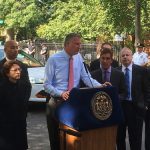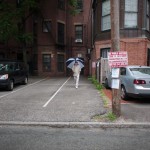Evolving politics of NYC’s “failure to yield” law
Some New York City bus drivers were up in arms after a fellow driver was arrested for failing to yield and fatally hitting a pedestrian in Brooklyn just before Christmas. The drivers, who protested by refusing to leave three bus depots for an hour and halting service, were soon back on the job, according to Gothamist, but the safety and political complications of a relatively unusual arrest for failure to yield are continuing into the new year.

Last week, bus drivers protested the arrest of a driver under New York’s failure to yield law who killed a pedestrian. Image from mtaphotos.
On December 23, B44 bus operator Reginald Prescott made a left turn, striking 78-year-old pedestrian Jean Bonne-Annee, who was reportedly in the crosswalk and had the right of way. Bonne-Annee died at the scene. Bus operator Prescott — who had been a city bus driver for about seven years with an otherwise clean record — remained at the scene and was later taken to the hospital for trauma, where he was arrested for failure to yield.
The enforcement of failure to yield as a criminal offense is relatively new in New York City. As part of the Vision Zero campaign, designed to drop pedestrian deaths to zero, the city passed a bill called NYC Administrative Code Section 19-190 back in May, which makes it a misdemeanor for drivers to injure or kill pedestrians or cyclists who have the right of way. Failure to Yield is the top cause of pedestrian fatalities in New York City, accounting for 27% of pedestrian deaths. Summons for this violation have jumped since Mayor Bill de Blasio took office.
Safety advocate and lawyer Steve Vaccaro told Gothamist that the law is a “game-changer.” Prior to August 22, when it went into effect, “a driver who without justification injured or killed a pedestrian with the right of way could not be arrested or charged with a crime—unless drunk, unlicensed, or fled the scene.” Under this new law, Vaccaro says, “criminality should be suspected…investigated, and, when there is reliable evidence, charged.” Vaccaro has also tweeted that the law has “probably been used about 5-10 times since it took effect,” but that it should’ve been implemented “100’s of times.”
Yet drivers and their advocates claim that “Bus drivers are not criminals,” as J.P. Patafio, vice-president at TWU Local 100, which represents bus drivers, told the Post. The officers who arrested Prescott told him, “This is ridiculous, but we have orders and we have to follow them,” and, as the Post reported, other drivers and union officials claimed it was “unheard of” for a driver to be arrested for an accident.
Union president John Samuelsen said in a statement, “This arrest was an absolute outrage and must not stand. Day-in and day-out, we deliver a tremendous service to this city under extremely adverse conditions. Subjecting transit workers to such treatment is nothing short of despicable.” He also said that union members want the Vision Zero law to be amended if a driver is involved in a fatal pedestrian accident.
But why shouldn’t drivers — whether city bus operators or ordinary drivers — be arrested for breaking the law? Driving is inherently a dangerous activity. One University of Michigan study found that about 63,000 buses of all kinds each year are involved in accidents, with about 14,000 resulting in injuries, and 325 resulting in a fatal injury. Statistics show that in 2011 in New York, a pedestrian was killed every 33 hours; in 60% of these fatal cases, the cause was drivers’ speeding or failure to yield, reports advocacy group Transportation Alternatives. Death wasn’t the only result, either: Every eight minutes, a New Yorker suffered a traffic-related injury; every three hours, a traffic-related injury caused permanent disability, dismemberment, or disfigurement.
While Prescott’s arrest drew outrage among the protesting drivers, there were a number of other comparable cases in the city last year that did not result in charges: a man fatally hit by a bus making a right turn; another man hit and killed by a bus making a right; a woman hit in an intersection by a bus making a right turn; a man hit in an intersection by a bus making a left turn. Since February 2014, nine pedestrians were killed by city buses in New York, but Prescott is the first driver to be charged.
Failure to yield, under certain circumstances, is already considered a misdemeanor in other jurisdictions: In Tennessee, if failing to yield results in a death, drivers may face a prison sentence of nearly 12 months and fines of up to $2,500, in addition to other consequences. In North Carolina last month, a bus driver who was making a U-turn and hit an oncoming SUV, killing its driver, is now being charged with misdemeanor death by motor vehicle and failure to yield. In Atlanta, a Metropolitan Atlanta Rapid Transit Authority bus driver was charged with two misdemeanors — failure to yield to a pedestrian, and homicide by vehicle in the second degree — after fatally hitting a 19-year-old in an intersection.
Back in New York, the Metropolitan Transportation Authority responded to safety concerns in a statement: “Our enhanced safety efforts include more robust training for bus operators, an upcoming pilot program for new technology to warn pedestrians and bus operators of potential collisions, and new public service announcements to raise awareness of safety risks. Managers are conducting more observational rides to ensure safe bus operation, and safe driving tips have been posted throughout bus depots. The result has been a 14% reduction in bus collisions involving pedestrians and a 6% reduction in bus collisions involving bicyclists.” Traffic-related deaths are at a low in New York City, reported the Daily News, with 2014’s pedestrian fatalities 26% lower than the prior year, and total traffic fatalities down by 13% since 2013.
Learn more about pedestrian safety and right of way law in New York City.
Related Posts
Category: Legislation

















